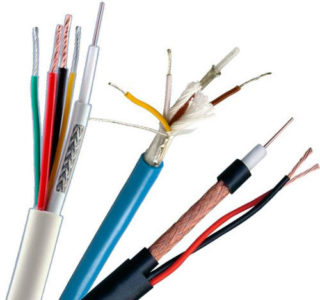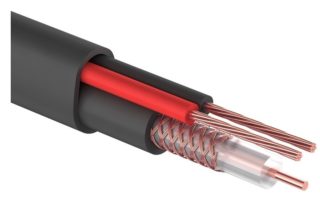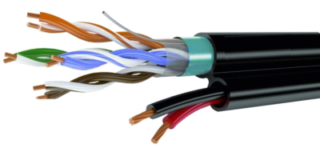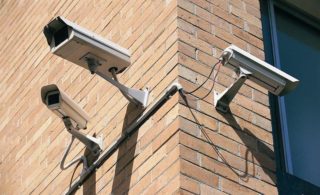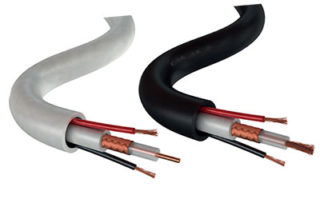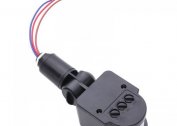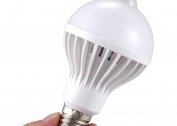The quality of installation and maintenance of a video surveillance system completely depends on which wires are used for cameras. To select the most suitable option, you will need to study the available varieties of cables, their advantages and disadvantages, as well as get acquainted with the features of the choice and installation recommendations.
Cable classification for CCTV and function
To choose the right cable for video surveillance, you should know in advance how its most popular varieties differ. The speed of information delivery from the camera to an additional element, for example, a microphone, depends on this detail. For each device, it is necessary to select a separate wire corresponding to it according to its characteristics.
Coaxial
A coaxial cable designed for video surveillance is ideally connected to analog devices. Outwardly, it resembles a wire connecting the antenna to a TV or other equipment. Its main advantage is maximum strength and protection from any mechanical influences due to the presence of a shielding shell, which also eliminates unnecessary interference and noise during operation of the internal or external camera. Such wires are divided into several types and differ in technical characteristics.
The most inexpensive are options with a small diameter of the cross section of the conductor, for example, RK-75-1.5 and RK-75-2. Models numbered RG-6 and RG-11 are used for laying over long distances, since they have a thicker section. In addition, they are distinguished by the degree of flexibility, insulation thickness, the number of shielding shells and the level of signal attenuation.
Combined
A combined version is needed to connect several surveillance devices to a power source located in one place. It is suitable for digital and analog devices, is considered a subspecies of the coaxial cable and is not inferior to it in strength. An element consists of several wires twisted together, due to which it is able to provide convenient and quick data access to all parts of the system.
Models are distinguished by marking, consisting of combinations of numbers in combination with letters. The number before the letter type designation determines the number of wires under the coating, as a rule it is 2 or 4 pieces. Decimal fractions after the cross indicate the cross-sectional diameter of the core. Its standard value is 75 ohms and should be the same for the camera, receiver and cable, so that the signal is transmitted cleanly and without interference.
Twisted pair
Twisted pair is used for remote surveillance, these wires are capable of transmitting information at distances up to 3 km. The plus of the cable is its versatility, since all the necessary conductors are contained in it under one braid. It allows you to connect multiple devices at once and is the most convenient option.
Fiber optic
Fiber optic cable is suitable for various types of video surveillance systems, as it is considered the most durable when compared with its analogues. These wires are not subjected to electromagnetic waves, are capable of transmitting data over long distances without attenuation of the signal.
Optical fiber is most often used for mounting cameras in large offices and industrial enterprises.
Installation tips
Cable installation specifics depend on the installation method, which can be internal or external. If wires are laid indoors, they must be made less visible and placed so that they are not exposed to physical damage. For protection use special cable channels or corrugation, which prevents the ingress of liquid and high temperatures.
The outdoor cable for installing video cameras must be fixed on walls, fences, poles and other supporting structures. It can also be laid in the air with suspension on cables, in pipes or trenches under a layer of soil. Protect wires lying on the surface using plastic or metal structures. During installation, it is worth observing the basic rules:
- the diameter of the cable should be half the diameter of the tube through which it is pulled;
- an optical wire for video surveillance is used, choosing elements of maximum length;
- the cable route is made as direct as possible without sharp turns;
- for installation, choose wires with minimal resistance, supplemented with high-quality connectors;
- video surveillance running along a twisted pair cable is not carried out parallel to the power lines.
When installing optical and other wires on the street, their operating conditions are taken into account. This includes increased humidity, a change in temperature conditions, as well as the effect of UK radiation in combination with mechanical loads.
Criteria for choosing a cable for camcorders
It is important to choose the right cable for your surveillance camera to ensure the stability of the entire system. For IP devices, it is better to use UTP wires with RJ-45 connectors, analog devices work well with coaxial elements if the distance between the recorder and the device is no more than 100-300 meters.
If signal transmission and power are carried out using one part, the combined option is ideal. When it comes to installing a large number of devices, it is worth giving preference to the options of the STP, UTP or FTP format and supplementing them with protection from interference.
External devices need wires with protective sheaths made of durable polyethylene, analogs with a PVC layer are suitable for internal ones.
When wireless is better than wires
A wireless connection is used when it is not possible to lay wires, for example, if they must pass through a river, into a building on the opposite side of the street, or on the territory of someone else's site. The solution to the problem are video senders or data transfer using infrared channels. The second option is used in the operation of remote controls for TV, air conditioning and other equipment. In order for the image to be transmitted via infrared, there must be direct visibility between the devices and there should be no short-term interference.
Wireless channels for connecting in a wireless format are considered the most profitable way to connect than a wire for standard surveillance cameras. Video senders are a set of transmitters and signal receivers. Simple models of such devices cost from $ 60, they are distinguished by low power and broadcast distance of up to 50 meters. The most expensive counterparts make it possible to increase the distance between the recorder and the receiver, as well as enable a larger number of cameras. The way these devices work is not complicated.
Transmitters and receivers do not require the installation of auxiliary drivers with cable connections. Wireless devices transmit the signal as unobtrusively as possible, and information will continuously go to the recorder.
Cable for connecting TV to the recorder
If the video signal transmission is to be displayed on a television screen, separate types of wires will be required to connect the camera to it.For this purpose, you can not use a cable for conventional analog video surveillance, it is better to give preference to other available options:
- HDMI Able to broadcast video and audio up to 50 meters, suitable for indoor installation, as it is exposed to the weather.
- VGA A computer-type video connector that transmits images up to a distance of 20 meters is not flexible and thin enough.
- RCA Mostly used for audio connection, not suitable for transmitting a good signal in video format.
You can also solve the problem using a conventional wireless mouse, its adapter is inserted into the USB port from the recorder and the cursor moves over the TV display. This method is considered the most convenient for setting up and controlling the entire system for video surveillance with a communication distance of up to 15 meters. It should be borne in mind that a conventional cable that is suitable for connecting a video camera is not connected to the TV, in this situation, you will need to purchase individual elements and accessories.
Pros and cons
Most often, coaxial and combined cables are used for cameras and video surveillance systems. The first option is mainly used when installing analog devices, so it is also called radio frequency. Of the advantages of such wires, increased resistance to various interference, reliability, the ability to transmit both audio and video signals in combination with an affordable price are noted. They also have their drawbacks, including the high cost of the connectors, the tendency to damage on bends and the distance limits for installation.
Combined cables are a more advanced analogue of coaxial cables and are complemented by two-wire wires for power and auxiliary parts of the system, for example, microphones. The list of advantages of such wiring includes the absence of the need for extra elements, full protection from any interference, ease of installation and transmission of signals of both types. The disadvantages of the combined options are their high cost, quick wear and the ability to use them only over short distances.
The combination cable is suitable for IP video surveillance and is considered the most rational option.
